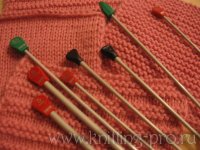 "How are you hanging around with these sticks?" I often asked my mom when she got in the chair with a knitting, and I was really tiny. This was the far-reaching Soviet years when only steel matches of domestic production with plastic ends were available, and plastics for the knitting of a moheer were available. I still have these matches, but I only use them in the most extreme cases when all the other appropriate sizes in my work. I won't describe their flaws, we'd better talk about how to pick matches for knitting.
"How are you hanging around with these sticks?" I often asked my mom when she got in the chair with a knitting, and I was really tiny. This was the far-reaching Soviet years when only steel matches of domestic production with plastic ends were available, and plastics for the knitting of a moheer were available. I still have these matches, but I only use them in the most extreme cases when all the other appropriate sizes in my work. I won't describe their flaws, we'd better talk about how to pick matches for knitting.
You've chosen a model, you've identified a buckle, and your hands are "checking," to start tying yourself or close-up. Take your time. First, we need to figure it out. knitting matches♪ What are they?
The matches are made from various materials, and this is the case of the ligamentary - which matches give preference to steel, aluminium with teflon, plasma or bamboo. It is clear from the name that the matches are made of. Steel matches are tight, but they're not sniffing and they're not breaking, they're sliding with a thread, if the match number matches the chosen buckle. Teflon matches are legs, they're also well slipped, but they can allergic to nectic people. Plastic and bamboo matches are the lightest, they're just unweight in their hands, they're loved by a lot of knickers, but I see two major shortcomings in them - they're easily broken and they're not as good as they'd like to slip hinges. The last flaw goes into dignity when we get out of the mohes and the hinges and run. There are still aluminium matches without a coating, but I think they're not going out anymore, and they're the worst matches - they're snooping, they're not sliding around them, and they're also snooping hands and buckling.
Personal experience: I prefer steel matches and teflon matches, plastics and bambooes I don't like, they're very light to me, I don't feel it in my hands, but maybe it's time and I'll be their fan.









